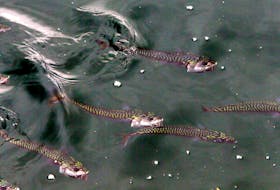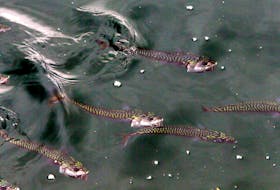
Frank Gale/TC Media
Ali Khan, manager of the hydrologic modeling section with the Water Source Management Division of the Department of Environment and Climate Change, talks about the ever-increasing amount of rainfall that Stephenville and area is receiving year-to-year.
More than 20 people from the two communities, which lie within the Stephenville municipal planning area, attended a recent Stephenville Town Council meeting, not wanting the adoption of the Stephenville Municipal Plan and Development Regulations 2014 to go forward due to restricting permits.
In comparison, only 11 people from the two communities attended this meeting, along with Scott Reid, MHA for St. George’s-Humber District, Coun. Tom Rose of Stephenville, and meeting organizer John Finn, MHA for Stephenville-Port au Port District.
Ali Khan, manager of the hydrologic modeling section with the Water Source Management Division of the Department of Environment and Climate Change, was joined by Chad Blundon, director of Climate Change with the same department, in explaining the science behind the changes.
Khan said for a number of reasons, including rainfall records kept for more than 40 years and various floods that has taken place, that Stephenville and area has become the most studied place in the province and beyond for flood risk mapping.
“In fact, the template we made for Stephenville has been adopted in many other communities here in this province and beyond to other provinces in Canada and the United States,” he said.
Blundon explained when it comes to flooding there are different kinds of risks and a section of Noel’s Pond, which was formerly a one in 100-year risk is now in the one in 20-year risk.
He said that doesn’t mean that a flood will happen once every 20 years, but that in any given year there is a five per cent chance of it happening, where the water flow is the fastest.
Blundon said the one in 100-year means a one per cent chance of flooding in any given year, where the water flow is slower.
Restricted development is permitted in the one in 100-year zoning but no permits in the one in 20-year.
Khan said from the data collected rainfall is changing significantly with Stephenville’s actual numbers showing a one per cent increase each year leading to a 10 per cent increase in the flow and high rainfall events becoming more frequent and by the year 2100 storms four times more commonplace.
In regards to the Wellhead Protection Area, he said this is approved based on studies and they are now to the point where a field hydrogeological study investigation needs to be done to verify sustainability under different development scenarios.
Khan said so far just desktop studies have been done and a field study is now needed.
Finn said he is hoping that in short order a study can be done and that Environment and Climate Change Minister Eddie Joyce is well aware of the situation.
“From a municipal standpoint, really good evidence is needed as the town has a legal responsibility for their wells and ensuring their drinking water is safe,” he said.








